The Oxford Dictionary states that a naturalist is someone who studies plants and animals. I have been doing both since moving to Mexico, but my first love was more on the side of animals. When I was young, we would go to the beach in the summer and catch flounder and dig clams. When we got home, I would go into the basement and scale and gut the fish, but many times I would do little dissections on them. Perhaps that is one of the reasons I became a nurse.
My strong stomach for things that might turn other people green was and continues to be a plus for my career and my continuing interest in these all types of creatures, with a whole new collections of critters to investigate here, south of the border. However, in deference to those with weaker constitutions, I am posting only photos from the plant kingdom here. I actually think I made a visitor from the U.S. a little sick when I found a half-eaten gecko (courtesy of one of my cats) on my patio and collected it for examination. I did hide it from him out of courtesy.
The Animal Kingdom
If you get queasy even reading about dissections, you can skip this part.
You have now been warned – continue at your own peril
OR
You can safely skip down to the Plant Kingdom section
Anyway, first the animal kingdom. As I stated, there are many animals here, as well as birds, that were not to be found in the often frigid climate of New York State. Cane toads that come out during the rainy season, and different types of spiders. Some spin webs, and I have seen at least two types of those, and spiders that do not spin webs (those are larger and with the legs extended are a rounded shape. They sit on the walls and are fast so I guess that is how they catch their prey. They also are skittish, and if you blow on them they scurry away).
There are also iguanas and my favorite – the geckos. I have seen different types of these little guys, some a little more stocky than others and slightly different colors. I used to see a lot of them before I got the cats, but now they are just about hunted to extinction, at least as far as my property goes. I get a little upset each time they kill one, as the geckos eat insects, but the cats are working cats, keeping my property free of pests and I don’t want to diminish their hunting instincts.
So – a few times, I saw dead geckos that my cats – named Durazna (Peach) and Ginger (Jengibre) by the way – had killed. I noticed what looked like little white balloons sticking out of their trunk. I had no idea what they were, and went on You Tube to see videos of dissections of geckos, but still didn’t see anything resembling what I was looking at. So, of course, I did dissections of two of them on my own. Still no answers, with the white rubbery spheres filling up their entire abdominal/thoracic cavity and when I opened them a liquid came out which resembled egg yolk.
I had recently visited my sister and brother-in-law in Chicago, and during that visit we went to the Field Museum. I figured that the museum must have a herpetologist on staff. Actually, I had to look up the professional title of a person that studies lizards, and then I searched the museum’s web site for that department.
I sent off an email to the museum describing what I had seen and my attempts to figure out what the facts were about these geckos. The museum connected me to a very nice herpetologist named Alan Resetar. We exchanged several emails, and I was quite pleased when he said I was “an excellent observer and natural historian.” I’m hoping he wasn’t just being nice to this strange woman who does little autopsies and dissections on little mangled creatures.
Anyway, turns out they were gecko eggs. The eggs are soft and very pliable and can take up almost the whole of their abdomen/thorax. After they are passed, they harden in the air. Depending on where they live, the geckos might also cover them with sand. According to Alan, “Depending on the species, geckos will lay eggs which can be adhered to walls once the eggs dry or placed in a more natural surrounding and even buried underground.”
If anyone cares to view the laying of the eggs, there are a bunch of videos on YouTube.
The Plant Kingdom
Rated G – Safe for everyone to read
OK – so now onto the plants and trees, although there is still interaction with the animal kingdom, mainly in the form of ants. My neighbor recently came to my house to gather some basil to make a medicinal tea, and I found that the ants had eaten all the leaves on all my basil plants. Every last one. They left all the other herbs intact, and I noticed they especially avoided the rosemary. So I bought three more basil plants at the local Green Market – two green and one dark purplish color – and for their health and well-being put them on a shelf at the back of the house. If the ants REALLY want them, they will have to climb up 5 layers of plastic shelving. Just to be safe, I check on them every day.
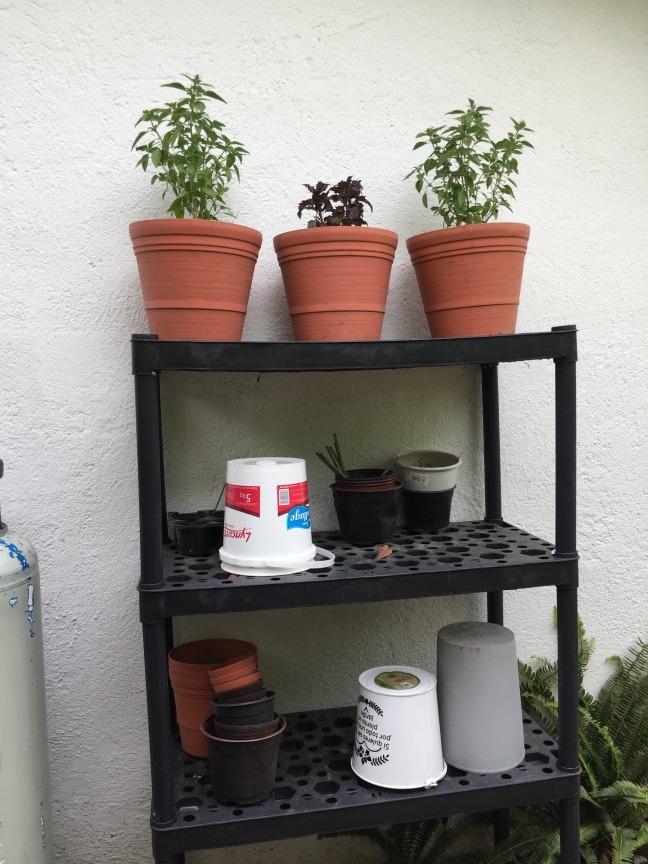
The ants also like peach tree leaves, and I also fear for my new cherry trees. Apparently, according to my gardener Angel, they don’t like the estafiate, which is blooming like nobody’s business, including around two of my cherry trees. So I will just let them be and now that it is the rainy season, I am sure my saplings will grow by leaps and bounds. But just to be safe, I’ve also put the Trompa pellets around them to attract any ants that might be tempted to indulge.
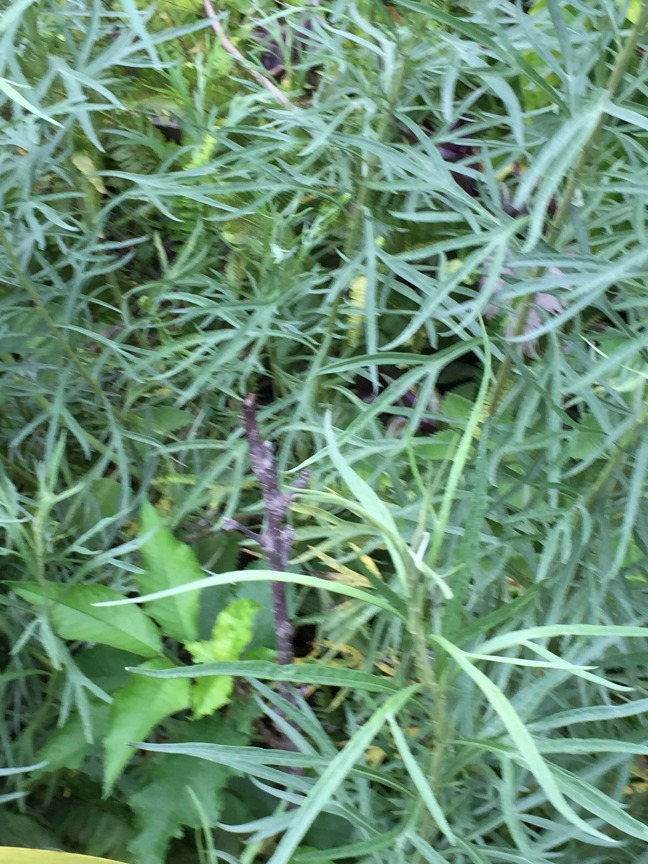
My sapling cherry tree with healthy leaves poking out from the estafiate.
Not all my plants were already here, nor purchased from a nursery. A while back I bought a few camotes – kind of like a sweet potato. I didn’t end up cooking them, and before very long, they were sprouting stems and leaves, so I just planted them in large flower pots. I noticed that even though they looked the same when I bought them, the leaves were quite different. I never would have known just by looking at them in the store, nor by the taste. Very strange, though Angel knew the names of the two varieties.
Both camote amarillo, but with different leaves.
And now there’s the issue of my banana trees. Heavy with fruit, but still green. So heavy that it now takes one metal rod and two heavy branches propped up against the trunk so the tree doesn’t fall over.
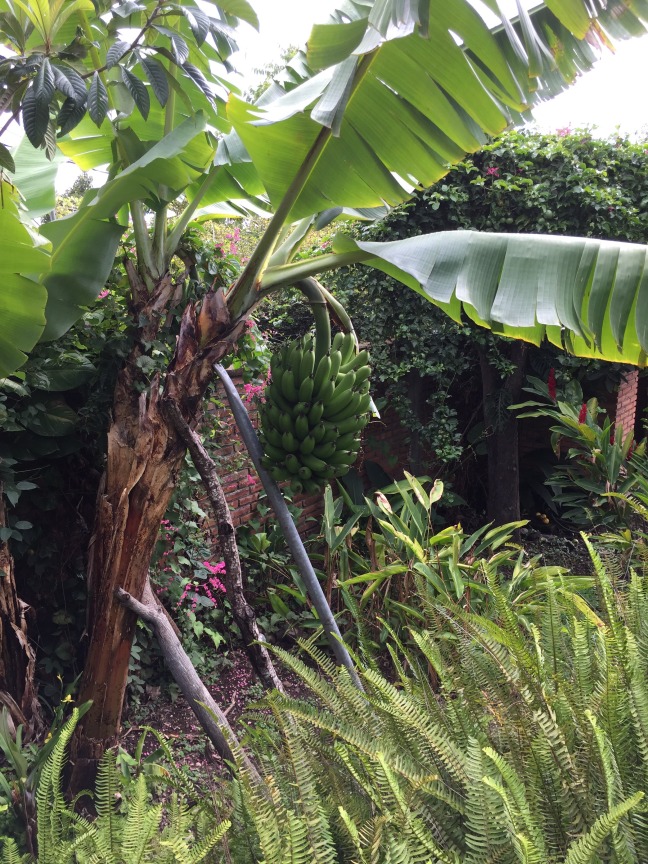 You can’t see it from this photo, but there are little daughter trees growing at the base. I lived here for over a year before the bananas started to form, and it is taking forever for them to ripen, even after putting lots of rich compost and organic fertilizer into the soil. So, obviously, for whatever reason, this is not a great spot for banana trees. Maybe they need more sunlight, I don’t know.
You can’t see it from this photo, but there are little daughter trees growing at the base. I lived here for over a year before the bananas started to form, and it is taking forever for them to ripen, even after putting lots of rich compost and organic fertilizer into the soil. So, obviously, for whatever reason, this is not a great spot for banana trees. Maybe they need more sunlight, I don’t know.
Because of this, we will be taking out a tree on another side of the property which is more sunny and planting the daughters there. Definitely won’t miss the tree that will be uprooted.
Maybe because the climate zone in which I live is great for all types of voracious creatures, many plants seem to protect themselves with a great natural defense – spines of various sizes – from thin, small, almost invisible one on tiny cactuses to the really large ones on this tree. Even when they are green and fresh, they are quite rigid, and when they harden into wood – watch out!
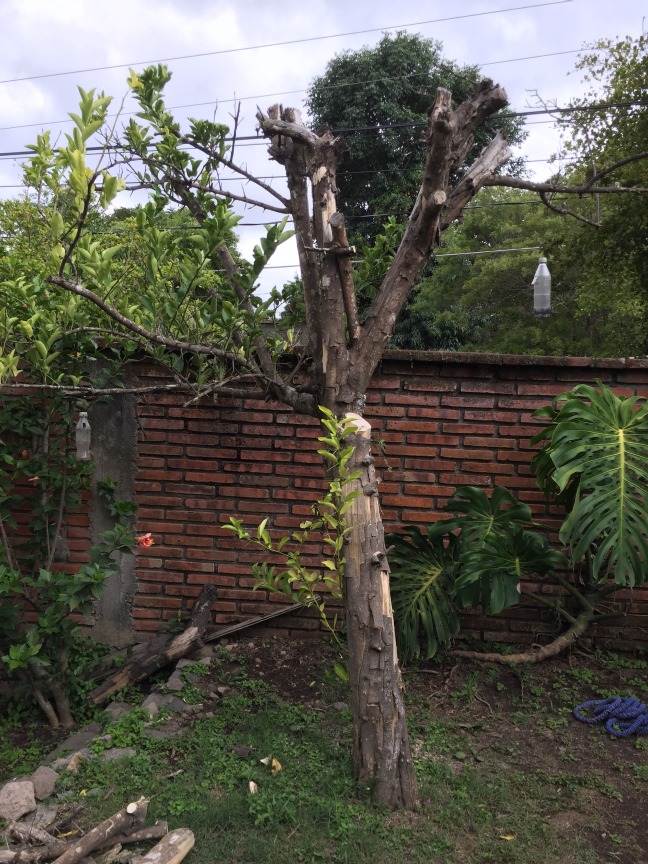
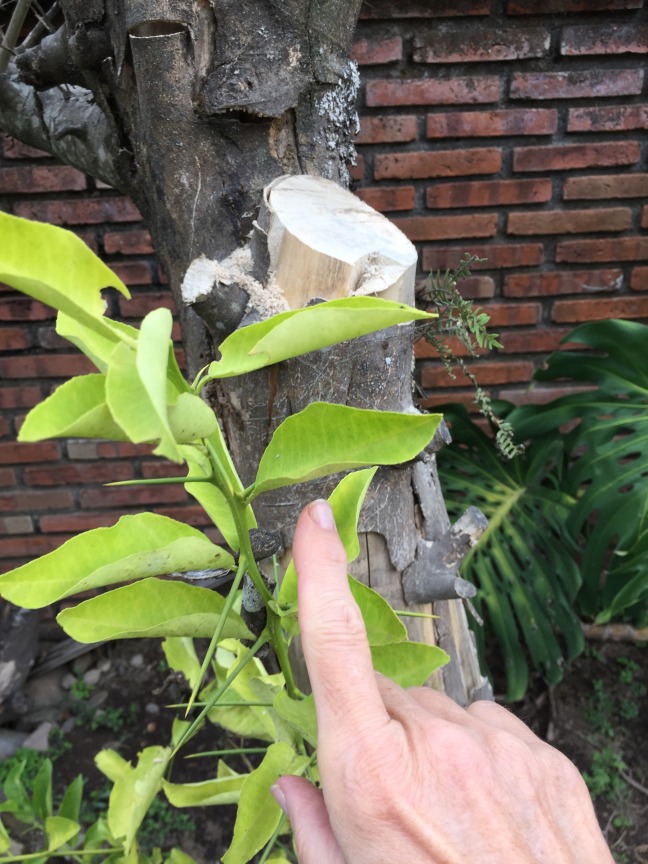
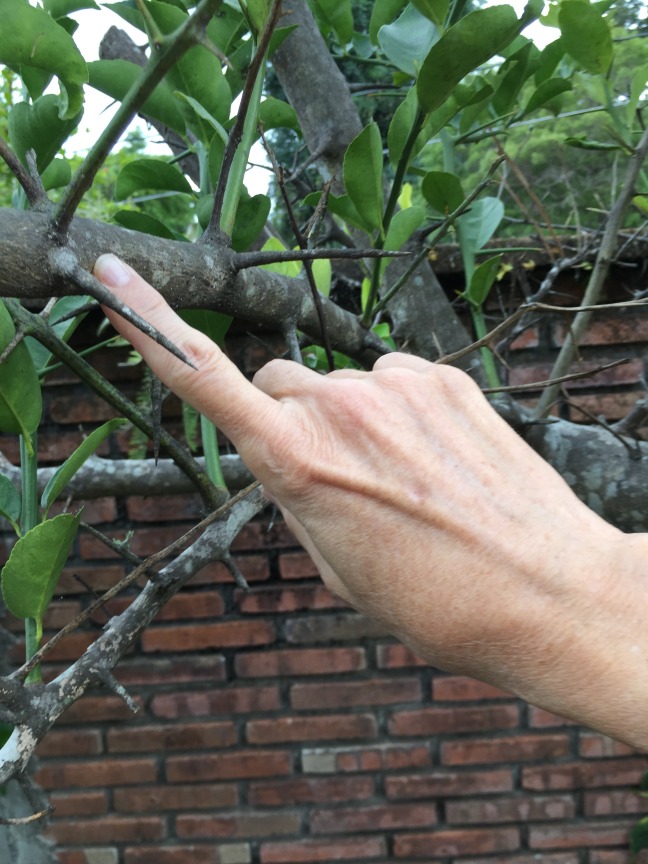
Hmmm – so what is left? My coffee saplings are doing fine – they should really be starting to grow with the rainy season now upon us.

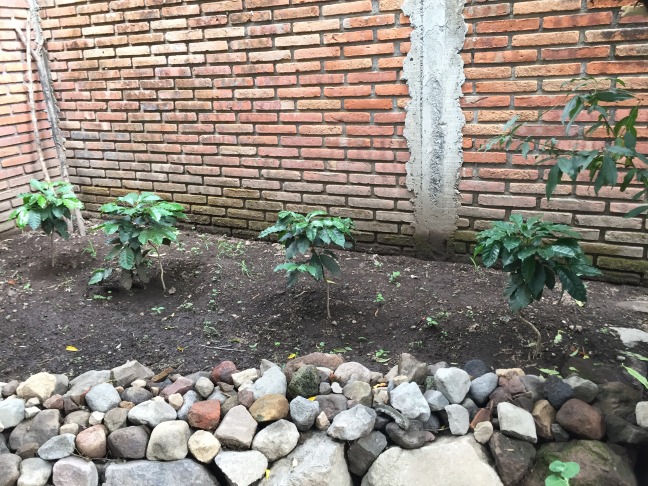
And, my yaca tree.. I have three new fruits growing. I have been told that when the fruit starts to turn brown, it is ready to be picked. According to what I have found on the internet, when it is less ripe, it tastes like fruit, and when it is more ripe, it can be used as a meat substitute. Guess I will have to wait to find out, though from the size of one of them, maybe not much longer. I have to let you know about the taste when I try it.
Hand visible to demonstrate the size of the fruit
And last but definitely not least, my chayote vines. They are growing like wildfire and the tendrils on the vines are reaching outward as well as upwards looking for anything on which to grab and extend their reach. Angel suggested rope or boards from the current frame to my roof. This will save me from having to wait for the chayotes to drop from the trees when they are too high for me to reach even with a tall ladder and my basket on a pole, which would extend my reach to about 13 or 14 feet in total. It will also provide some more shade and a nice look to the area with a living green roof, so to speak.
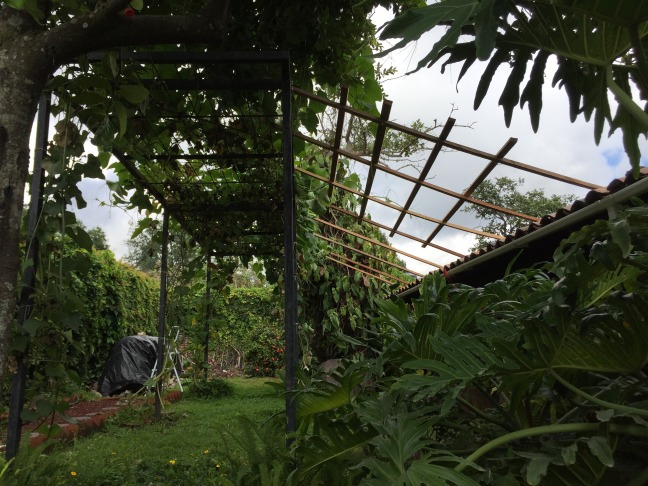
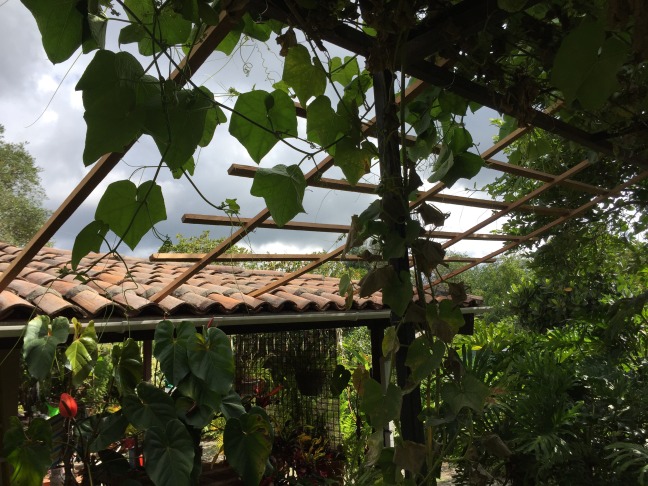
The frame isn’t finished, but you get the idea of what it will look like
So that’s all the latest news coming purely from inside my property. Hope I didn’t bore you all too much, but after all the stress of my former profession and the hustle and bustle of living in New York, I am very happy living on my little patch of God’s green Earth, exploring the wonders and variety of life right here.
When I decide to stop procrastinating, I really have to photograph and catalog all my medicinal plants. When that happens, there will be a new post with photos, names and their medicinal use, according to the women here who have the knowledge which has been passed down to them.
Until them, to all my readers, have a great day, wherever you are…. Hasta luego!





Well done! Love the photos!
******************* Susan Hill Huizilacate #6 Cofradia de Suchitlan, CP 28460 Colima Tel in Mexico: +52 312-395-4146
In USA: 1701 Novato Blvd #302 Novato, CA 94947 Cel in USA: 415 755-8619 *********************
>
LikeLike
Thanks!
LikeLike
the garden looks gorgeous.
Could you be too high up for banana trees to flourish? I saw them in Hawaii (the Big Island) but they were at low altitude – pretty near the coast, in fact – and in an area where it drizzles rain every day. The proprietor told me that from first shoot to harvestable bananas was about 18 months.
Gecko eggs … in retrospect it seems obvious, but I was flummoxed too, by the description.
LikeLike